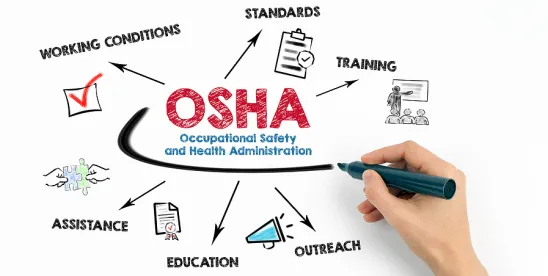On the heels of California’s new indoor heat illness prevention standard becoming effective, the federal Occupational Safety and Health Administration (“OSHA”) announced a proposed national heat and injury illness prevention standard (“Proposed Rule”). The Proposed Rule covers indoor and outdoor workplaces where the heat index reaches 80°F or higher. Employers who wish to submit comments on the Proposed Rule have until December 30, 2024 to do so.
1. Background
A national heat illness prevention regulation has been in the works since 2021. In April 2022, OSHA rolled out its Outdoor and Indoor Heat Related Hazards National Emphasis Program to encourage employers to reduce or eliminate worker exposures to heat-related hazards that result in illnesses, injuries, and deaths. In July 2023, OSHA announced a three-year National Emphasis Program to address heat-related workplace hazards in warehouses, processing facilities, distribution centers, and high-risk retail establishments. On July 2, 2024, OSHA announced its Proposed Rule and, on August 30, 2024, it published its Notice of Proposed Rulemaking for “Heat Injury and Illness Prevention in Outdoor and Indoor Work Settings”. The public has until December 30, 2024 to submit comments on the Proposed Rule. After the close of the comment period and public hearing, if one is held, OSHA must publish the final rule in the Federal Register, along with an explanation of the standard and the reasons for implementing it. OSHA may also publish a determination that no standard needs to be issued, but that seems unlikely absent a change in the administration.
2. Overview of the Proposed Rule and HIPP
The Proposed Rule features many of the same requirements as California’s indoor and outdoor heat illness regulations. It applies to employers with employees who work indoors or outdoors where the heat index reaches 80°F or higher for more than fifteen minutes in any sixty-minute period. Covered employers must evaluate heat risks, create and implement a written heat injury and illness prevention plan (“HIIPP”), and implement various measures to prevent and minimize the risk of heat illness. The HIIPP must include a comprehensive list detailing the types of work activities covered and include necessary policies and procedures to comply with the Proposed Rule. It must also include the heat metric used for monitoring heat conditions. Employers must regularly review and update the HIPP. Furthermore, employers are obligated to assess and update the HIIPP’s effectiveness whenever a heat-related illness requiring medical attention results in an absence from work.
The Proposed Rule also calls for the development of acclimatization plans for new or returning workers unfamiliar with working in high heat conditions. Employers must provide training on the HIIPP, establish procedures for responding to signs and symptoms of heat-related illnesses, and take immediate measures to assist workers in heat emergencies. Additionally, employers must designate “heat safety coordinators” and provide employees with emergency contact numbers and clear instructions on what to do if someone shows symptoms of a heat-related illness.
3. Monitoring Heat Exposure
The Proposed Rule requires employers to evaluate and monitor heat exposure levels. For outdoor work areas, employers have the option to use local heat index forecasts or conduct on-site measurements to determine when the initial and high heat triggers are met. For indoor workplaces, employers must identify potential high-heat exposure areas and develop a comprehensive monitoring plan to ensure timely activation of protective measures. Employers must monitor and document their chosen metric–heat index in their HIIPP.
Under the Proposed Rule, there are two separate triggers for initiating certain protective protocols, an “initial heat trigger” and a “high heat trigger.” The initial heat trigger occurs when the heat index reaches 80°F, while the high heat trigger requires a heat index of 90°F. The Proposed Rule outlines an employer’s requirements under both heat triggers. Employers may skip the monitoring requirement if they assume that heat exposure exceeds both triggers and comply with the Proposed Rule’s other requirements.
4. Specific Requirements for Initial Heat Trigger
Employers must comply with the following requirements when the initial heat trigger (80°F heat index) occurs:
- Provision of Drinking Water: Employers must provide drinking water to employees as close as possible to the employee work area. Employers must supply at least one quart of water per employee per hour at no cost to employees. The water must be kept at a reasonably cool temperature. Employers may use water coolers, food-grade jugs, or bottled water.
- Cool-Down Rest Breaks: Employers must allow and encourage employees to take paid rest breaks in designated shaded or air-conditioned break areas. At indoor worksites, the proposed rules requires break areas to be air-conditioned or equipped with a combination of increased air movement and, where necessary, dehumidification. In outdoor worksites, employers must ensure conveniently located break areas that are easily accessible and equipped with either shade or enclosed air-conditioned spaces. Shade can be either natural or artificially created and employers should consider the movement of shade throughout the day. If air-conditioned break areas are provided, such areas must be sufficiently spacious and accessible.
- Acclimatization: The proposed rule requires employers to implement an acclimatization protocol for new employees and employees absent for more than 14 days. The Proposed Rule offers two options to ensure workers adjust safely to heat exposure. Option A requires adherence to high heat trigger measures like 15-minute breaks (discussed below) every two hours, monitoring for heat-related illness symptoms, and providing hazard alerts, regardless of gradual exposure. Option B allows for a gradual introduction to heat, starting with 20 percent exposure on the first day and increasing daily. Exceptions to these requirements exist if employers can demonstrate that an employee has worked in similar or hotter conditions recently and is already acclimated.
- Symptom Observation: Employers must train all employees on recognizing the signs and symptoms of heat-related illnesses and emergencies, emphasizing the importance of immediate action in such cases. The Proposed Rule outlines three methods for employers to monitor employees for signs and symptoms of heat-related illness, including a buddy system, observation by a supervisor or heat safety coordinator, and a communication protocol for employees working alone. Under the buddy system, employees work in pairs within the same area, using visual and verbal cues to monitor each other for heat stress symptoms. Alternatively, a supervisor or heat safety coordinator can observe no more than twenty employees, ensuring they are in close enough proximity to effectively monitor and communicate with the employees under their watch. For lone workers, employers are required to maintain effective two-way communication, checking in at least every two hours to ensure their safety.
- Effective Communication: The Proposed Rule emphasizes the necessity for effective, two-way communication between employers and employees once the initial heat trigger is reached. Employers must maintain regular, effective communication, which could involve direct voice communication, hand signals, or electronic means such as handheld transceivers or phones, ensuring timely responses to any reported issues. This includes a requirement for a method of communication for workers who operate alone.
- Personal Protective Equipment: Notably, employers are not required to supply cooling personal protective equipment to employees. However, if they choose to, they must ensure its cooling properties are consistently maintained during use.
5. Specific Requirements for High Heat Trigger
In addition to complying with the above, employers must comply with the following requirements when the high heat trigger (90°F heat index) occurs:
- Mandatory Cool-Down Rest Breaks: Once a high heat trigger is met, employers must provide a fifteen-minute paid rest break for every two hours of work. These breaks are in addition to other requirements, such as allowing additional rest if needed to prevent overheating. Such breaks must be taken in designated break areas.
- Heat Hazard Alert: Employers must notify employees about key safety measures against heat hazards, including the necessity of hydration, the right and requirement to take rest breaks, how to respond in heat emergencies, and the location of break areas and water for mobile work sites. A hazard alert, must be issued before the work shift begins if high heat conditions are expected from the start, or as soon as such conditions are recognized during the workday. Employers have the flexibility to use various communication methods to issue these alerts, including electronic means, verbal communication, or posting signs, ensuring the information is accessible and understandable to all employees. The Proposed Rule also requires employers to install warning signs at indoor work areas where ambient temperatures frequently surpass 120°F.
6. Recordkeeping
For indoor work areas where employees may be exposed to heat levels at or above the initial trigger level, employers must create and maintain written or electronic records of on-site temperature measurements. These records must be kept for a minimum of six months.
7. Training
Employers must provide comprehensive initial training for all employees exposed to heat hazards before they undertake any work that could expose them to high heat. This training should cover the prevention of heat-related illnesses and injuries, ranging from understanding heat stress hazards, recognizing the signs and symptoms of heat-related illnesses, the importance of hydration and rest breaks, and the proper use of personal protective equipment. Training must be conducted in a language that is understandable by employees.
The Proposed Rule also requires supplemental training in several instances, such as when employees are assigned new tasks that change their exposure to heat. An annual refresher training is also mandated to ensure that all employees, including supervisors and heat safety coordinators, remain informed about heat hazards, especially before the start of a high heat season.
8. Takeaways
Although the Proposed Rule will not take effect until 2025 and will likely face several legal challenges, employers should proactively consider whether the heat triggers exist in their workplace(s) and whether they will need to comply. Additionally, certain protocols in particular, like providing drinking water and a cool-down area (especially in outdoor workplaces), may require substantial time and effort to set up. Employers with any questions about compliance should consult with experienced employment law counsel.
This article is not an unequivocal statement of the law, but instead offers some potential issues to consider with counsel. This is provided for informational purposes only and does not constitute legal advice and is not intended to form an attorney-client relationship.




 />i
/>i
